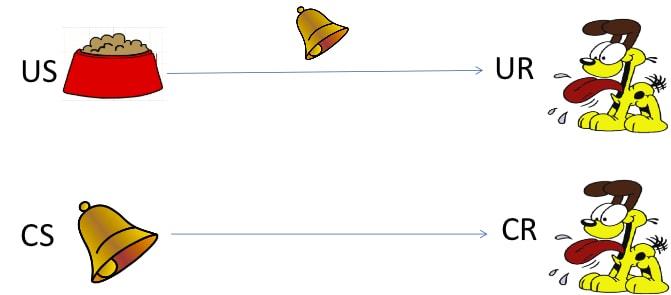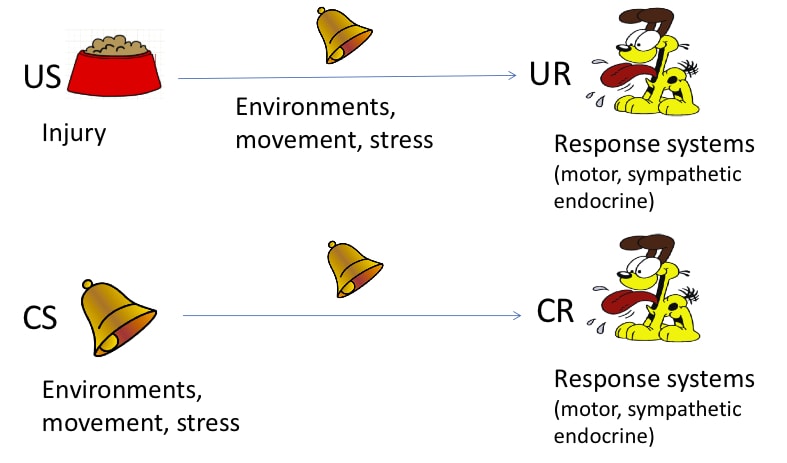The way we perceive and respond to various circumstances or ‘stimuli’ changes over time. This is called (drum roll) learning. Implicit learning is the term we give to learning that occurs outside of consciousness or awareness. Examples of implicit learning include non-associative learning (habituation and sensitisation) and associative learning (operant and classical conditioning).
In the realm of chronic pain, “problem learning” discussion usually revolves around the processes of sensitisation (i.e. central) and operant conditioning (i.e. development of habitual pain behaviours through reinforcement processes).
Ironically, perhaps the most famous form of learning has received the least attention by researchers in chronic pain. I am of course talking about “classical conditioning,” made famous by Ivan Pavlov and his four salivating canines (AKA respondent conditioning or Pavlovian conditioning). Just as Pavlov’s dogs were conditioned to reflexively salivate in response to a bell, might humans learn reflexive physiological responses (such as increase muscle tone) under a similar process of conditioning?
Classic conditioning
Figure 1: The frequent co-occurrence of an unconditioned stimulus (US) with a conditioned stimulus (CS) results in a conditioned response (CR) to the conditioned stimulus.
According to Flor and Turk, such an idea was first proposed by Gentry and Bernal in 1977 (Flor and Turk 2012). In this model frequent co-occurrence of harmless stimuli (such as activities and environments) with acute pain states (and the resultant motor, sympathetic and endocrine responses) may result in a direct relationship between the previously neutral stimuli and the physiological responses (motor, sympathetic and endocrine).
The classical conditioning paradigm applied to chronic pain.
Figure 2: The frequent co-occurrence of injury related stimuli (the unconditioned stimulius [US]), with certain environments, movements and injury related stressors (the conditioned stimulus[CS]), results in a conditioned response (CR) to the conditioned stimulus in the absence of the unconditioned stimulus (Flor and Turk 2011).
Interestingly, I reckon this model fails to include the modern concept of pain as a response/output rather than an input (see (Moseley 2003). If we were to integrate the elegant stuff from Flor & Turk with Moseley’s outputs thing (although I KNOW he would claim ownership over it), it gives birth to a new idea of “classically conditioned pain”. That is, not only could it be possible for conditioned stimuli to contribute to the maintenance of pain indirectly (through motor, sympathetic and endocrine systems), but it may also be possible for them to directly activate pain responses (or neurosignatures in the words of the great Ron Melzack (1999).
I am just starting this journey and I know Lorimer has already got some exciting data on this idea, but as I get my head around it, I think others should too – a closer look at the classical conditioning paradigm should inspire new research on whether aberrant responses can be conditioned in chronic pain and look at how these may be extinguished. In fact, Flor and others have played around with this idea (Flor and Birbaumer 1994; Schneider, Palomba et al. 2004), but it doesn’t seem to have gone all that far, and again, is taking an input paradigm into it, rather than an output paradigm.
If you are at all interested – check out Chapter 3 of “The Psychology of Pain” in Chronic Pain: an integrated biobehavioral approach by Herta Flor and Dennis C. Turk, and the papers referenced below.
About Daniel Harvie
 Daniel is a recently commenced PhD candidate in the Body in Mind Research Group at UniSA. He has a clinical physiotherapy background and is a graduate of the Master of Musculoskeletal and Sports degree at the University of South Australia. His research will look at the application of learning models to the development and extinction of chronic pain.
Daniel is a recently commenced PhD candidate in the Body in Mind Research Group at UniSA. He has a clinical physiotherapy background and is a graduate of the Master of Musculoskeletal and Sports degree at the University of South Australia. His research will look at the application of learning models to the development and extinction of chronic pain.
He enjoys writing and recording music, hasn’t had a car for 3 months (an experiment) and has a bionic knee.
References
Flor, H. and Turk, D. “The Psychology of Pain” in Chronic Pain: an integrated biobehavioral approach.
FLOR, H., & BIRBAUMER, N. (1994). Acquisition of chronic pain*Psychophysiological mechanisms APS Journal, 3 (2), 119-127 DOI: 10.1016/S1058-9139(05)80339-0
Flor, H. and D. C. Turk (2011). Chronic pain: an intergrated biobehavioral approach. Seattle, IASP press.
Moseley, G. (2003). A pain neuromatrix approach to patients with chronic pain Manual Therapy, 8 (3), 130-140 DOI: 10.1016/S1356-689X(03)00051-1
Ronald, M. (1999). “From the gate to the neuromatrix.” Pain 82, Supplement 1(0): S121-S126.
Schneider C, Palomba D, & Flor H (2004). Pavlovian conditioning of muscular responses in chronic pain patients: central and peripheral correlates. Pain, 112 (3), 239-47 PMID: 15561378





